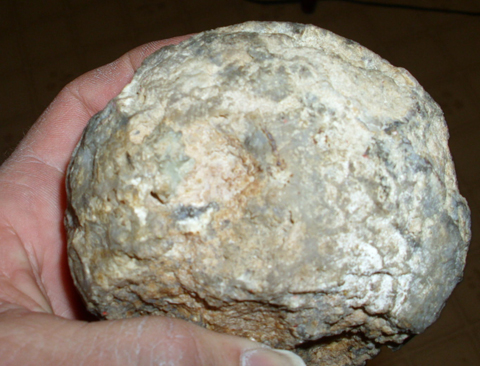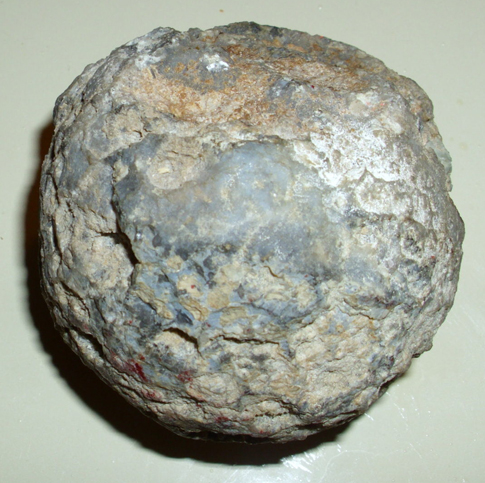Geopuzzle: What is this rock?
February 4, 2010
I received an e-mail from a reader asking my opinion about a rock they found and, as in previous occasions (e.g., here and here), I figured it would make a good Geopuzzle. I also recommend checking out Andrew Alden’s resources for identifying rocks over at About.com.
This one was found near Brandenburg, Kentucky. To be perfectly honest, this one is pretty difficult … I’d like to take a hammer to it to see if most of what’s highlighted in these photos is just surficial.
What do you think? Share your guesses in the comments below.
41 Comments
leave one →



It looks like an Oncolite. Essentially a giant Ooid or conversely a small Stromatolite
I’m putting my money on a thunderegg.
marcasite nodule?
Is it a chert nodule?
It does have a patterned look to it, but not regular enough to be a fossil. The roundness is not definitive of anything–could be a geode core or a fossil cast. The mineral may be fluorite, considering the location and color, or silica or even opal. We need a scratch test. On the whole I would go with an authigenic, not organic origin.
I’m with Ron — I think it’s a geode… especially coming from karst country…
I’m with Ron: Thunderegg or geode.
The reader who sent these pictures in did wonder about it being a geode as well, so maybe we’re reaching a consensus here. Sounds reasonable to me, which is why I mentioned I’d like to take a hammer to this thing :)
You mean we don’t get to see what’s inside????????????????????????
Have your reader do a density test to see if it is hollow. Does s/he have a gram-accurate kitchen scale? pure quartz is 2.65 g/cc
My first thought was thunderegg, or geode. It looks like agate or other microcrystalline silica on the outside. Both thundereggs and geodes are fairly common in places in the west. I wouldn’t have thought they were common in Kentucky – but Callan doesn’t seem to have a problem with that, so… break it open!
Geodes are very common in the Kentuckiana (northern Kentucky/southern Indiana) region. I can’t imagine someone from this area *not* assuming it’s a geode….
..late due to the time difference…but.. I would go for silica geode too..
one more for team thunderegg.
Or, pretty much anywhere in the state where Mississippian rocks are exposed. Though, not common, beautiful acicular xls of sulfides and sulfates can be found in Ky geodes, so I would encourage the contributor to crack the thing.
Be kind to the nice geode – and cut it open with a good rock saw.
I am going to try something completely different and just wonder if this cannot be some man-made material. I remember a trick one of my geology professors pulled on us in the first geology field trip I went as an undergrad. As we were crossing a small creek in the S. Carpathians, he reached down and pulled out of the water this nicely shaped and rounded conglomerate-looking rock and asked us “what is this”? Everybody made theses very eloquent and elaborate interpretations. He waited patiently then told us it was a piece of man made material and pointed out upstream to this concrete bridge where this piece originated from. We walked there (he made us walk in the water, to experience first hand the “forces” that round and sort the rocks in a river bed) and, sure enough, we proved the source.
So, just a thought, can it be a man-made concoction?
I have yet to hear back from this reader … but, perhaps they will be willing to do some hypothesis testing with a hammer!
I vote for a quartz intrusion into basalt. I have a similar rock I picked up in Oregon, which was part of the trigger of my career path change from Electronics to Geology.
Other than a couple of pegmatites, there are no intrusives in Ky.
I’m with the consensus- when in doubt-use rock hammer. My guess would be it is geode/thunderegg. Rock saw would make a nicer cut if they are worried about damaging it. I’d be too impatient to wait for access to the latter though..
FYI — I never heard back from the reader who sent this in … when/if I do and there is more information to share I will put up a new post. Thanks all for playing!
A cannon ball that has been steeping in a chemical stew for a century or so?
Its a geode. most likely chalcedony. KY perhaps?
Brian,
So happy to find your site. I am a very amateur geologist. And I came from British Columbia, Canada to Alamogordo New Mexico. I am very interested in the Lake Valley Region, and my house is so full of rocks that myself and my son have collected it’s crazy. So many unusual things here. We have found many small fossils, and these odd round rocks that, when broken open have three or four layers of solid rocks that are distinctly colored. They all seem to have a solid central core. My son calls them ‘rock eggs’. Your site is wonderful, and very helpful to someone like me who has a deep interest and respect in the earth. We would like to see the crinoid fossil that you found, do you know how you got there ? Also, any idea what the rock eggs are ? I’ll try and post a pic.
Forgot to ask…..Do you know if there are any geodes in the area ? I’d love to show my son
one “in the wild”……Any area you think would be interesting to a nine year old ? We’d love to
hear about it……….. Thanks, Deborah
Deborah, I do not know all that much about the Alamogordo area. I’m not sure which crinoid you are talking about … maybe you can link to it? In terms of the ‘rock eggs’, my best guess w/out seeing them is they are some sort of concretion, but that’s only a guess!
It’s conglomerate. It is not a thunderegg or geode as we have many where I live and they are very distinct. We have conglomerate from all over the u.s. and this looks like some of the conglomerate that we found in upper washington this past spring.
DEBORAH, where do you live? I live in Northern California and I can tell you exactly where to go to find geodes in the wild for your son. They are everywhere at this site and I have shown people that do not have a smooth surface nor do they look like they are from this planet and yet there they are…
i’m from northern to so where can i go to find thwem here thnx
I too live in the Northern California area and would love to go search for geodes with my children. Can you share the location?
It’s Amethyst, I know that. It may also be a geode, so crack it open and see what’s inside! It’ll look alot better on the inside.
geode !
Dear Chopper Mcgone again. I live in New Mexico, i was born in California. We used to find geodes in the St Helena, Angwin, Calistoga areas. But in New Mexico i have no idea.
Ok so I know this is an old post but its the best thing I’ve found so far. I have a small rock and I have no idea what it is. I collected rocks as a kid and this was in my collection. We live near Elberton Ga (“Granite Capital of the World”) so I’m suspicious that its some sort of granite. Please please please help! Here is a link to my photobucket album with pictures of the rock.
http://s267.photobucket.com/user/Beaded_Butterfly/library/What%20is%20it
Thank you!!!
Cassie … it *might* be chalcopyrite (do a Google image search to see other examples), but I’m not certain. A good community and resource for figuring out rocks/minerals is this Facebook group: https://www.facebook.com/InquiringRockHunters
Cassie … another geologist (@rschott on Twitter) commented that it might be bornite (also known as ‘peacock ore’)
Wow Thank you so much! I believe its chalcopyrite. The pictures of bornite just don’t look quite right. I will inquire with the InquiringRockHunters as well. Thank you for all the information! You’re the best!!
It’s a meteorite made during creation. It has the book of Genesis inscribed. Creation encompasses entire rock. Indentions if any and layout of rock is the property or land it 1st landed. To scale and how the specimen will forever break until it disappears. So if a meteorite shower hit the area it will show on the specimen to scale. Rock has 2 sides. A vibrant one filled with character, the other almost formless and void of life (but that’s far from the Truth) 1st side garden of Eden, back side after they both ate apple. Ridges are the “snakeS” and actually the arms of both hugging each other and feeding one another the fruit of knowledge. The hands of both makes each snake head and both devouring the fruit. These rocks formed at creation (compared to new rocks made from trees) all have the actual history recorded by super mineralomycin when entering Earth’s atmosphere. History of creation and detailed survey of it’s landing. Since we’re all connected by this net of matter the Omycin record everything. Everyone and everything from all mater you move through. So it’s true, he knows when u are sleeping, he knows when you’re awake. He knows when you’re bad or good,bso be good for goodness sake 🥰
We found one very similar broke it open an it has Crystal’s it it . My nephew said he thinks its dinosaur poop ..
We found one very similar broke it open an it has Crystal’s it it .